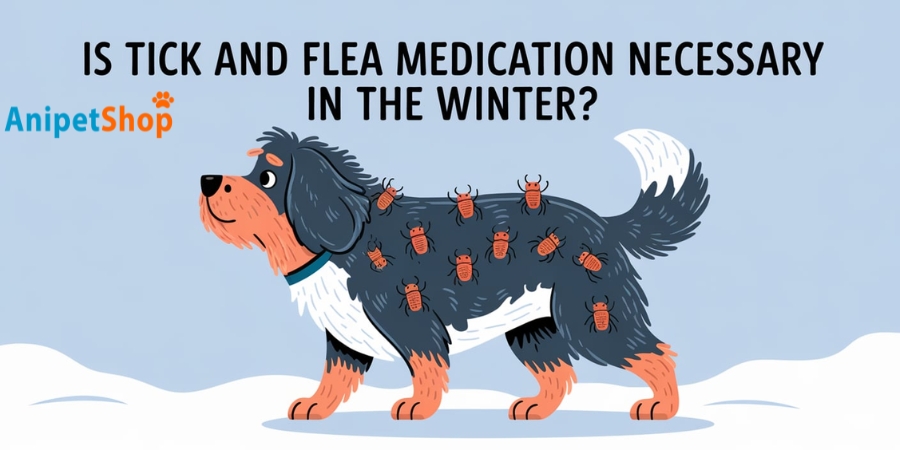Can Dogs Get Fleas in Winter?
Many pet owners assume winter means a break from flea and tick prevention, but these pests can remain active year-round. Certain ticks, like blacklegged and brown dog ticks, survive cold temperatures, and fleas often find refuge indoors or in warmer outdoor areas, allowing them to thrive even in winter. A brief warm spell can quickly reactivate fleas and ticks, posing health risks to your pet, including infestations and disease transmission. Consistent use of flea and tick prevention treatments during the winter is far easier than addressing a full infestation later, making it essential to protect both your pet and home year-round.

Can Dogs Get Fleas in Winter?
Yes, dogs can get fleas in winter, even though colder temperatures might reduce outdoor flea activity . Fleas can survive on wildlife, in sheltered outdoor spaces, or inside your home, where warmth and central heating create an ideal environment for them to thrive. Once indoors, fleas can reproduce quickly, infesting your pet and living spaces. Additionally, wildlife such as squirrels and raccoons can carry fleas, bringing them closer to your pet during outdoor activities or even transferring them directly.
Fleas in the pupal stage can also remain dormant for extended periods during the winter, only to emerge when they sense warmth or movement, such as your dog walking nearby. To prevent a winter flea infestation, it’s essential to continue regular flea prevention treatments, inspect your dog for fleas frequently, and maintain a clean living environment. While winter might bring colder weather, it doesn’t eliminate the risk of fleas, so staying proactive is crucial to keeping your dog and home flea-free.
Is Tick and Flea Medication Necessary in the Winter?
Yes, it’s important to continue flea and tick prevention for your dog during the winter months. Although many flea and tick species slow down or enter dormancy when outdoor temperatures drop, winter conditions in certain parts of the United States don’t get cold enough to kill these pests or halt their activity completely. Fleas can survive in temperatures as low as 33°F, and some tick species remain active down to 32°F. Even in colder regions, all it takes is a brief warm spell for these parasites to reactivate.
Additionally, fleas can find their way indoors during winter, especially on pets that go in and out of the house. Indoor heating provides a warm environment where fleas can thrive, making it easy for them to reproduce and infest your pet and home. Ticks, too, can be picked up during milder winter days and pose a risk if brought indoors. Since fleas and ticks can transmit serious diseases year-round, it’s safest to keep your dog on a consistent preventative treatment plan throughout the winter. This continuous protection helps guard against unexpected infestations and ensures your dog stays safe from parasites, no matter the season.
Here are some effective flea and tick medications for dogs:
- Frontline Plus: A topical solution designed for both dogs and cats, Frontline Plus protects against fleas, ticks, flea eggs, flea larvae, and chewing lice. It comes in easy-to-use, pre-measured applicators that provide one month of continuous protection.
- Seresto Flea & Tick Collar: This collar uses a slow-release formula to protect dogs from fleas, ticks, chewing lice, and mange mites for up to eight months, offering extended coverage with minimal maintenance.
- NexGard: An oral chewable that eliminates fleas, paralysis ticks, brown dog ticks, and bush ticks. NexGard offers one month of protection and is often convenient for dogs that don’t tolerate topical treatments.
- Simparica Trio: A monthly chewable tablet that provides comprehensive protection by killing fleas and ticks, preventing heartworm, and treating intestinal parasites such as hookworm and roundworm.
- Advantage Flea & Tick Treatment Shampoo: An unscented shampoo that helps control fleas and ticks on dogs. It’s ideal for immediate relief, though it should be used alongside other preventative medications for lasting protection.

Risks of Fleas in the Winter
Fleas can be a year-round problem in milder climates where it rarely gets cold enough for them to go dormant. Even in regions with harsh winters, fleas can find shelter in warm places such as barns, sheds, animal dens, or even inside and under homes. It only takes one warm day for fleas to emerge and reestablish activity, and they can quickly infest any animal that crosses their path.
Flea populations often surge after heavy rains or weather events like hurricanes, which create ideal conditions for fleas to breed and spread. Additionally, winter travel with your dog to areas with mild climates increases their risk of exposure to fleas. In these regions, fleas remain active year-round and can carry harmful diseases. For pets in winter, staying on a consistent flea preventative helps avoid these risks and keeps them protected from disease-carrying fleas wherever they go.
Risks of Ticks in the Winter
Certain tick species remain active even in winter temperatures, particularly in warmer parts of the United States. Blacklegged ticks in the South, western blacklegged ticks along the West Coast, and brown dog ticks throughout the southern U.S. can all survive and seek hosts through the winter months. The Gulf Coast tick, which can transmit tick paralysis, can remain active in temperatures as low as 39.2°F, allowing it to survive in many regions that don’t experience hard freezes. This tick’s range is expanding beyond Gulf Coast states, increasing its presence in previously unaffected areas.
Ticks are resilient parasites, and their activity is only halted by extremely low temperatures. Even in colder climates, just a brief period of warmer weather can reactivate ticks. For this reason, it’s essential to keep your dog on tick prevention medication throughout the winter to guard against tick-borne diseases, especially in areas where temperatures may fluctuate or reach mild conditions.
Fleas Don’t Die Easily in the Winter
While cold weather can slow down a flea’s life cycle, it doesn’t necessarily kill them off. Fleas can survive in temperatures as low as 46°F, and even freezing temperatures may not be enough to eliminate them completely. In fact, it can take up to five days of consistently freezing temperatures to kill adult fleas, and even then, fleas may have already found a warmer place to lay their eggs.
The flea’s life cycle allows it to endure the cold. A female flea can start laying eggs within 24 to 36 hours of biting your pet, and a single flea can lay up to 10,000 eggs in just 30 days. These eggs often fall into carpets, bedding, or other areas around your home, where they can remain dormant. Flea larvae form cocoons and can stay in the pupal stage for up to 30 weeks before emerging as adults, making it hard to eradicate them completely.
In milder climates or regions where temperatures don’t drop below 46°F, fleas can survive outdoors throughout the winter. Even in areas that experience freezing temperatures, the warmth inside your home—often above 46°F—creates an ideal environment for fleas to thrive. Additionally, the temperature on your pet’s body is perfect for fleas, allowing them to continue feeding and reproducing even when outdoor conditions are harsh.
This means that even during the colder months, your pet is still at risk of bringing fleas home, especially if they spend time outdoors in places like dog parks or hiking trails.
Fleas Might Still Be Active Indoors
During the winter, one of the warmer places fleas may seek refuge is inside your home. While cold weather can slow them down outdoors, fleas can remain active and continue their life cycle indoors. Temperatures between 70–85°F, combined with 70% humidity, create the perfect environment for fleas to thrive. As a result, they may take shelter in these warmer areas when it’s cold outside.
Your home is probably not cool enough to hinder flea activity. If you stop using flea treatments in the winter, you could be giving fleas the opportunity to establish themselves indoors.
It’s Easier to Prevent Fleas than to Get Rid of an Infestation
Preventing fleas is far simpler than dealing with a full-blown infestation. Fleas reproduce rapidly and are resilient, so by the time you notice them, they may have already spread throughout your home or yard. Fleas can also bring additional issues, like tapeworms.
For these reasons, it’s important to maintain year-round flea prevention, not just in the warmer months. Since adult fleas on your pet account for only about 5% of the total flea population in your home, it’s crucial to treat the environment as well. Addressing both your pet and their surroundings is essential for faster and more effective flea control.
Winter doesn’t eliminate the risks that fleas and ticks pose to your pet, so maintaining year-round prevention is essential. By using consistent flea and tick treatments, you help protect your pet from potential infestations and diseases that can occur even in colder months. Taking these preventive measures during winter creates a safer, healthier environment for both your pet and household, saving you the hassle and expense of dealing with a full-scale infestation later. With regular protection, you can ensure your pet stays comfortable and safe, regardless of the season.
FAQs
How do you get rid of fleas in the winter?
A good flea-and-tick shampoo is a smart first step to use with your pet. Regularly wash fabrics in your home, vacuum carpets, and clean areas that are ideal environments for fleas to help prevent re-infestation.
What month do fleas go away?
Fleas are most active from March to November, peaking in summer months (June to August). In warmer climates, they can remain a problem year-round. In colder regions, flea activity typically decreases by late fall (October or November) and may not resume until late spring (April or May). However, flea eggs and larvae can survive indoors during winter, so it’s essential to maintain preventative measures year-round to avoid infestations when temperatures rise again.
At what temperature do fleas die off?
Adult fleas die at temperatures colder than 46.4°F (8°C) and hotter than 95°F (35°C). Immature fleas, which refers to both flea eggs and larvae, are slightly more susceptible to the cold, dying at temperatures below 55.4°F (13°C)
Lily Watson is an author specializing in veterinary care in Australia. With a profound passion for animal welfare and a solid foundation in veterinary science, Lily has dedicated herself to disseminating valuable knowledge and information for both pet owners and professionals in this field.

